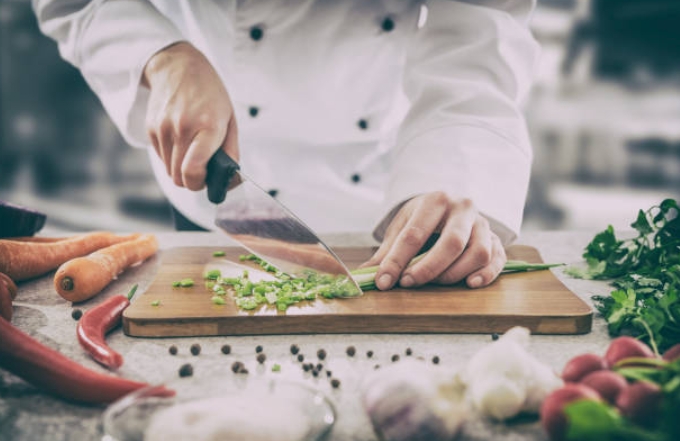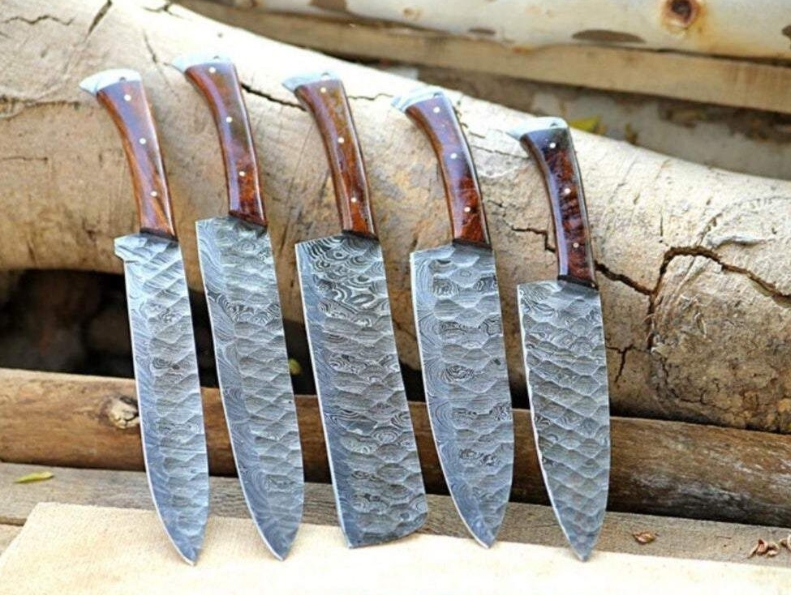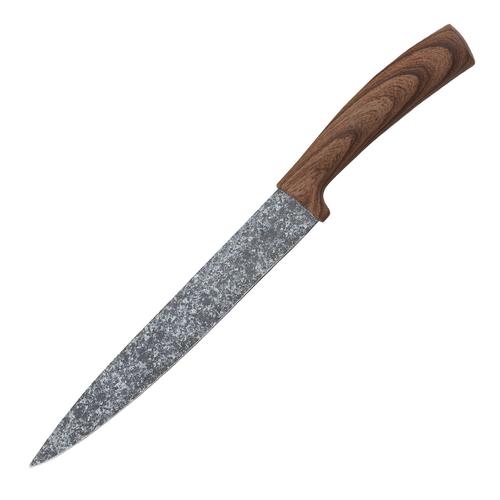

Views: 222 Author: Ella Publish Time: 2025-05-06 Origin: Site








Content Menu
● Understanding Rust: The Science Behind the Problem
● Knife Materials: Which Are Most Prone to Rust?
>> Ceramic
>> Titanium
● Common Causes of Rust in Knife Sets
>> Cutting Acidic or Salty Foods
● How to Prevent Knife Rust: Comprehensive Strategies
● Visual Guide: Knife Care in Practice
● Step-by-Step: Removing Rust from Your Knives
● Advanced Knife Maintenance Tips
>> Use a Knife-Specific Cutting Board
>> Avoid Prolonged Contact with Acidic Foods
>> Regularly Inspect Your Knives
>> Use Blade Guards for Transport
● The Role of Knife Construction and Finish
>> Blade Finish
● Myths and Misconceptions About Knife Rust
>> Myth: Stainless Steel Never Rusts
>> Myth: Dishwashers Are Safe for Knives
>> Myth: Expensive Knives Don't Rust
>> Myth: Oil Is Only for High-Carbon Steel
● Troubleshooting: What to Do If Your Knives Keep Rusting
● The Environmental Factor: How Climate Affects Knife Rust
● The Long-Term Benefits of Proper Knife Care
● FAQ: Knife Rust Prevention and Care
>> 1. Why do stainless steel knives rust even though they are labeled "stainless"?
>> 2. Can I put my knives in the dishwasher if they're stainless steel?
>> 3. What is the best oil to use for preventing knife rust?
>> 4. How do I remove rust spots from my knives safely?
>> 5. Why do some expensive knives rust more easily than cheap ones?
Knives are the backbone of every kitchen, from the simplest home setups to the most advanced professional culinary environments. However, one of the most common frustrations for cooks and chefs alike is discovering unsightly rust spots or even deep corrosion on their prized knife sets. Why do some knives seem to rust at the slightest provocation, while others remain pristine for years? More importantly, how can you avoid this problem and ensure your knives stay sharp, safe, and beautiful for a lifetime? This comprehensive guide will take you deep into the science of rust, the materials and manufacturing processes behind knife sets, and the best practices for maintenance and storage. By the end, you'll be equipped with everything you need to keep your knives in top condition.

Rust is not just a cosmetic issue; it's a chemical process that can compromise the integrity of your knives. At its core, rust is the result of oxidation, a reaction between iron, oxygen, and moisture. When iron or steel is exposed to water and air, it forms iron oxide, which we recognize as rust.
But not all metals rust at the same rate, and not all rust is the same. The composition of the steel, the environment in which the knife is used, and how it is cared for all play significant roles. Let's break down the main factors:
- Moisture: Water is the catalyst for rust. Even a small amount of moisture left on a knife can start the rusting process.
- Oxygen: Air exposure is unavoidable, but when combined with water, it accelerates oxidation.
- Salt: Salt acts as an electrolyte, speeding up the chemical reaction and breaking down protective layers on the blade.
- Acids: Acidic foods such as tomatoes, citrus, and vinegar can eat away at the metal, making it more susceptible to rust.
- Contact with Other Metals: Storing knives with other metal utensils can cause galvanic corrosion, where one metal corrodes faster than it otherwise would.
- Improper Storage: Damp environments, wet sheaths, or enclosed spaces without ventilation can trap moisture and encourage rust.
The type of steel or material your knife is made from is the single most important factor in how easily it will rust. Here's a closer look at the most common materials used in kitchen knives:
Stainless steel is the most popular material for kitchen knives because it contains chromium, which forms a thin, invisible layer of chromium oxide on the surface. This layer protects the steel from oxygen and moisture, making it highly resistant to rust. However, “stainless” does not mean “rust-proof.” If the chromium layer is damaged or the knife is left wet for long periods, rust can still form.
High carbon steel knives are beloved by chefs for their sharpness and edge retention. However, they lack the chromium content of stainless steel, making them much more susceptible to rust and staining. These knives require diligent care, including immediate cleaning and drying, regular oiling, and sometimes even developing a protective patina.
Ceramic knives do not contain iron, so they do not rust. They are lightweight, extremely sharp, and ideal for slicing fruits and vegetables. However, they are brittle and can chip or break if dropped or used on hard surfaces.
Titanium knives are lightweight, strong, and completely resistant to rust and corrosion. However, they are typically more expensive and may not hold an edge as well as high-quality steel.
Understanding why some knife sets rust more easily than others can help you avoid common pitfalls. Here are the most frequent culprits:
The most common mistake is leaving knives wet after washing. Even a few minutes of moisture can start the rusting process, especially in humid environments.
Dishwashers are harsh environments for knives. The combination of high heat, humidity, and abrasive detergents can strip away protective coatings and trap moisture against the blade, leading to rust.
Storing knives in damp drawers, wet sheaths, or enclosed spaces without ventilation can trap moisture and promote rust. Magnetic strips, knife blocks, and open racks are better options if they are kept dry and clean.
Foods like tomatoes, citrus fruits, and salted meats can leave behind acids and salts that corrode metal. If knives are not cleaned promptly after use, rust can develop quickly.
Cheaper knives often use lower-grade steel with less chromium or protective coatings. These knives are more likely to rust, even with proper care.
Failing to regularly clean, dry, oil, and sharpen your knives increases the risk of rust. Maintenance is especially important for high-carbon steel knives.

Now that you understand the causes, let's explore the best ways to prevent rust and keep your knives in pristine condition.
Always hand-wash your knives with mild soap and warm water. Avoid abrasive sponges or harsh chemicals that can damage the blade. Dry the knife thoroughly with a soft towel immediately after washing, paying special attention to the area where the blade meets the handle.
Never put your knives in the dishwasher. The high heat, moisture, and detergents can damage both the blade and the handle, and promote rust. Hand-washing is always best.
Proper storage is crucial. Use a knife block, magnetic strip (preferably wood-faced), or a protective sheath. Make sure the storage area is dry and well-ventilated. Avoid storing knives in damp drawers or with other metal utensils.
Applying a thin layer of food-safe oil creates a barrier against moisture and oxygen. This is especially important for high-carbon steel knives. Use mineral oil, camellia oil, or specialized knife oils. Wipe off any excess oil before use.
A sharp edge is less likely to develop rust, as it is less damaged and easier to clean. Regular sharpening and honing keep the blade in top condition and remove any micro-corrosion before it becomes a problem.
If you notice rust spots, address them immediately. Use a rust eraser, fine steel wool, or a baking soda paste to gently remove the rust. Clean and dry the knife thoroughly afterward, and apply a protective oil layer.
For high-carbon steel knives, developing a patina can provide a protective barrier against rust. A patina is a dark, stable layer that forms naturally over time or can be encouraged using vinegar or other acidic solutions. This layer helps protect the underlying steel from further oxidation.
- How to Remove Rust from a Knife
- How I Protect My Knives from Rust
1. Wipe Off Surface Moisture: Use a dry cloth to remove any water.
2. Apply Baking Soda Paste: Mix baking soda with water and apply to rust spots.
3. Gently Scrub: Use a soft cloth or fine steel wool to scrub the area.
4. Rinse and Dry: Wash off the paste, dry thoroughly.
5. Oil the Blade: Apply a thin layer of oil for extra protection.
Cutting on hard surfaces like glass, stone, or ceramic can damage the blade and make it more susceptible to rust. Use wooden or plastic cutting boards, which are gentler on the edge.
If you need to cut a lot of acidic foods, rinse and dry your knife periodically during use. This prevents acids from lingering on the blade and causing corrosion.
Make a habit of inspecting your knives for signs of rust, pitting, or staining. Early detection makes removal easier and prevents further damage.
If you live in a humid climate or near the ocean, consider using silica gel packs or dehumidifiers in your kitchen to reduce moisture in the air.
When transporting knives, use blade guards or sheaths to protect the blade and prevent moisture buildup.
Not all knives are created equal, even within the same material category. The way a knife is constructed and finished can greatly affect its resistance to rust.
Forged knives are made from a single piece of steel that is heated and shaped, resulting in a denser, more durable blade. Stamped knives are cut from a sheet of steel and tend to be thinner and less resistant to rust.
Some knives feature a polished or mirror finish, which helps repel water and resist rust. Others have a matte or brushed finish, which can hold onto moisture and food particles, increasing the risk of corrosion.
Handles made from wood, bone, or other porous materials can absorb moisture and transfer it to the blade. Synthetic handles are generally more resistant to water and less likely to contribute to rust.
There are many myths surrounding knife care and rust prevention. Let's debunk some of the most common:
Fact: Stainless steel is rust-resistant, not rust-proof. Poor care can still result in rust spots.
Fact: Dishwashers can cause significant damage to both the blade and handle, and promote rust.
Fact: High-end knives often use high-carbon steel, which is more prone to rust than cheaper stainless steel.
Fact: Oiling can benefit all types of steel, especially in humid environments.
If you've followed all the best practices and your knives still rust, consider the following:
- Check Your Water: Hard or mineral-rich water can leave deposits that promote rust.
- Evaluate Your Storage: Ensure your storage area is truly dry and well-ventilated.
- Inspect Your Cleaning Tools: Abrasive sponges or dirty towels can introduce contaminants.
- Consider Upgrading: If your knives are made from low-quality steel, even the best care may not prevent rust. Investing in higher-quality knives can save you time and frustration.
Your local environment plays a significant role in how quickly knives rust. Coastal areas with salty air, or regions with high humidity, can accelerate corrosion. In such environments:
- Use dehumidifiers or silica gel packs in your kitchen.
- Oil your knives more frequently.
- Store knives in airtight containers or cabinets if possible.
Rust is not just unsightly; it can also be a food safety concern. Small rust spots are generally not dangerous, but deep rust or pitting can harbor bacteria and compromise the structural integrity of the blade. Always remove rust promptly and avoid using heavily corroded knives for food preparation.
Investing time in proper knife maintenance pays off in multiple ways:
- Longer Lifespan: Well-cared-for knives can last decades, even generations.
- Better Performance: Sharp, rust-free knives cut more cleanly and safely.
- Cost Savings: Avoiding replacement costs for damaged knives.
- Aesthetic Appeal: A well-maintained knife set looks impressive and professional.
Knife rust is a common but preventable problem. By understanding the science behind rust, choosing the right materials, and following best practices for cleaning, drying, oiling, and storage, you can keep your knife set in peak condition for years to come. Remember that even the best knives require care and attention. With the right approach, you'll enjoy sharp, safe, and beautiful blades that enhance your cooking experience and stand the test of time.

Stainless steel resists rust due to its chromium content, but it is not completely rust-proof. If the protective chromium oxide layer is damaged or the knife is left wet, rust can still form.
No. Dishwashers expose knives to moisture, heat, and harsh detergents, which can damage the blade and handle, and promote rust even on stainless steel.
Food-grade mineral oil, camellia oil, or specialized knife oils are best. They are safe for kitchen use and create an effective moisture barrier.
Use a paste of baking soda and water, a rust eraser, or fine steel wool. Gently scrub the affected area, rinse, dry, and oil the blade afterward.
High-end knives often use high-carbon steel for better sharpness and edge retention, but this material is more prone to rust than lower-quality stainless steel. Proper care is essential to prevent rust.